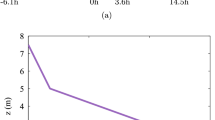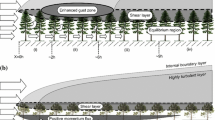Abstract
Laser Doppler anemometery and laser-induced fluorescence techniques were used to explore the spatial structure of the flow within and above finite cavities created within porous and solid media. The cavities within these two configurations were identical in size and were intended to mimic flow disturbances created by finite gaps and forest clearing. Because flows over permeable boundaries differ from their solid counterparts, the study here addresses how these differences in boundary conditions produce differences in, (i) bulk flow properties including the mean vorticity within and adjacent to the gaps, (ii) second-order statistics such as the standard deviations and turbulent stresses, (iii) the relative importance of advective to turbulent stress terms across various regions within and above the gaps, and (iv) the local imbalance between ejections and sweeps and momentum transport efficiencies of updrafts and downdrafts. Both configurations exhibited a primary recirculation zone of comparable dimensions inside the gap. The mean vorticity spawned at the upstream corner of the gap was more intense for the solid configuration when compared to its porous counterpart. The free-shear layer spawned from the upstream corner-edge deeper into the gap for the porous configuration. The momentum flux at the interface within and above the gap was enhanced by a factor of 1.5–2.0 over its upstream value, and this enhancement zone was much broader in size for the porous configuration. For the turbulent transport terms in the longitudinal and vertical mean momentum balances, these transport terms were significant inside the gap for both boundary configurations when compared to their upstream counterpart. The effectiveness of using incomplete cumulant expansion methods to describe the momentum transport efficiencies, and the relative contributions of ejections and sweeps to turbulent stresses, especially in this zone, were also demonstrated. The flatness factor for both velocity components, often used as a measure of intermittency, was highest in the vicinity of the upstream corner in both configurations. However, immediately following the downstream corner, the flatness factor remained large for the porous configuration, in contrast to its solid configuration counterpart.
Similar content being viewed by others
References
Antonia RA (1981) Conditional sampling in turbulence measurements. Annu Rev Fluid Mech 13: 131–156
Albertson JD, Parlange MB (1999) Surface length scales and shear stress: implications for land–atmosphere interaction over complex terrain. Water Resour Res 35: 2121–2132
Ashcroft G, Zhang X (2005) Vortical structures over rectangular cavities at low speed. Phys Fluids 17: 015104-1–015104-8
Batchelor GK, Townsend AA (1949) The nature of turbulent motion at large wavenumbers. Proc R Soc A 199: 238–255
Belcher SE, Jerram N, Hunt JCR (2003) Adjustment of a turbulent boundary layer to a canopy of roughness elements. J Fluid Mech 488: 369–398
Cassiani M, Katul GG, Albertson JD (2008) The effects of canopy leaf area index on airflow across forest edges: large-eddy simulation and analytical results. Boundary-Layer Meteorol 126: 433–460
Cava D, Katul GG, Scremieri A, Poggi D, Cescatti A, Giostra U (2006) Buoyancy and the sensible heat flux budget within a dense canopy. Boundary-Layer Meteorol 118: 217–240
Detto M, Katul GG, Siqueira MB, Juang JY, Stoy P (2008) The structure of turbulence near a tall forest edge: the backward facing step flow analogy revisited. Ecol Appl 18: 1420–1435
Dupont S, Brunet Y (2008) Edge flow and canopy structure: a large-eddy simulation study. Boundary-Layer Meteorol 126: 51–71
Durst F, Jovanovic J, Johansson TG (1992) On the statistical proprieties of truncated Gram-Charlier series expansions in turbulent wall-bounded flows. Phys Fluids A 4(1): 118–126
Fer I, McPhee MG, Sirevaag A (2004) Conditional statistics of the Reynolds Stress in the under-ice boundary layer. Geophys Res Lett 31: 2004GL020475
Finnigan J (2000) Turbulence in plant canopies. Annu Rev Fluid Mech 32: 519–571
Frenkiel F, Klebanoff P (1967) Higher order correlations in a turbulent field. Phys Fluids 10: 507–522
Irvine MR, Gardiner BA, Hill MK (1997) The evolution of turbulence across a forest edge. Boundary-Layer Meteorol 84: 467–496
Katul GG, Hsieh CI, Kuhn G, Ellsworth D, Nie D (1997) The turbulent eddy motion at the forest–atmosphere interface. J Geophys Res 102: 13409–13421
Katul GG, Geron CD, Hsieh CI, Vidakovic B, Guenther AB (1998) Active turbulence and scalar transport near the land–atmosphere interface. J Appl Meteorol 37: 1533–1546
Katul GG, Poggi D, Cava D, Finnigan D (2006) The relative importance of ejections and sweeps to momentum transfer in the atmospheric boundary layer. Boundary-Layer Meteorol 120: 367–375
Klaassen W (1992) Average fluxes from heterogeneous vegetated regions. Boundary-Layer Meteorol 58: 329–354
Laurence W (2004) Forest climate interactions in fragmented tropical landscapes. Philos Trans R Soc Lond 359: 345–352
Li D, Bou-Zeid E (2011) Stability effects on turbulent coherent structures and transport efficiency in the atmospheric surface layer. Boundary-Layer Meteorol 140(2): 243–262
Manes C., Poggi D., Ridolfi L. (2011) Turbulent boundary layers over permeable walls: scaling and near-wall structure. J Fluid Mech 687: 141–170
Nakagawa H, Nezu I (1977) Prediction of the Reynolds stress from bursting events in open-channel flows. J Fluid Mech 80: 99–128
Poggi D, Porporato A, Ridolfi L (2002) An experimental contribution to near-wall measurements by means of a special laser Doppler anemometry technique. Exp Fluids 32: 366–375
Poggi D, Katul GG, Albertson JD (2004) Momentum transfer and turbulent kinetic energy budgets within a dense model canopy. Boundary-Layer Meteorol 111: 589–614
Poggi D, Katul GG, Albertson JD (2006) Scalar dispersion within a model canopy: measurements and three-dimensional Lagrangian models. Adv Water Resour 29: 326–335
Poggi D, Katul GG, Vidakovic B (2011) The role of wake production on the scaling laws of scalar concentration fluctuation spectra inside dense canopies. Boundary-Layer Meteorol 139: 83–95
Pope SB (2000) Turbulent flows. Cambridge University Press, UK, 771 pp
Raupach MR (1981) Conditional statistics of Reynolds stress in rough-wall and smooth-wall turbulent boundary layers. J Fluid Mech 108: 363–382
Raupach MR, Finnigan JJ, Brunet Y (1996) Coherent eddies and turbulence in vegetation canopies: the mixing layer analogy. Boundary-Layer Meteorol 78: 351–382
Sandborn VA (1959) Measurements of intermittency of turbulent motion in a boundary layer. J Fluid Mech 6: 221–240
Schlegel F, Stiller J, Bienert A, Maas HG, Queck R, Bernhofer C (2012) Large-eddy simulation of inhomogeneous canopy flows using high resolution terrestrial laser scanning data. Boundary-Layer Meteorol 142: 223–243
Seraphin A, Guyenne P (2008) A flume experiment on the adjustment of the mean and turbulent statistics to a transition from short to tall sparse canopies. Boundary-Layer Meteorol 129: 47–64
Simpson RL (1989) Turbulent boundary layer separation. Annu Rev Fluid Mech 21: 3808–3818
Spazzini PG, Iuso G, Onorato M, Zurlo N, Di Cicca GM (2001) Unsteady behavior of back-facing step flow. Exp Fluids 30: 551–561
Thomas KF, Wilson JD (1999) Wind and remnant tree sway in forest cutblocks. I. Measured winds in experimental cutblocks. Agric For Meteorol 93: 229–242
Veen WL, Klaassen W, Kruijt B, Hutjes RWA (1996) Forest edges and the soil–vegetation–atmosphere interaction at the landscape scale: the state of affairs. Prog Phys Geogr 20: 292–310
Wyngaard JC, Moeng CH (1992) Parameterizing turbulent diffusion through the joint probability density. Boundary-Layer Meteorol 60: 1–13
Yang B, Raupach MR, Shaw RH, Tha K, Paw U, Morse AP (2006a) Large-eddy simulation of turbulent flow across a forest edge. Part I: flow statistics. Boundary-Layer Meteorol 120: 377–412
Yang B, Morse AP, Shaw RH, Tha K, Paw U (2006b) Large-eddy simulation of turbulent flow across a forest edge. Part II: momentum and turbulent kinetic energy budgets. Boundary-Layer Meteorol 121: 433–457
Author information
Authors and Affiliations
Corresponding author
Rights and permissions
About this article
Cite this article
Fontan, S., Katul, G.G., Poggi, D. et al. Flume Experiments on Turbulent Flows Across Gaps of Permeable and Impermeable Boundaries. Boundary-Layer Meteorol 147, 21–39 (2013). https://doi.org/10.1007/s10546-012-9772-z
Received:
Accepted:
Published:
Issue Date:
DOI: https://doi.org/10.1007/s10546-012-9772-z




